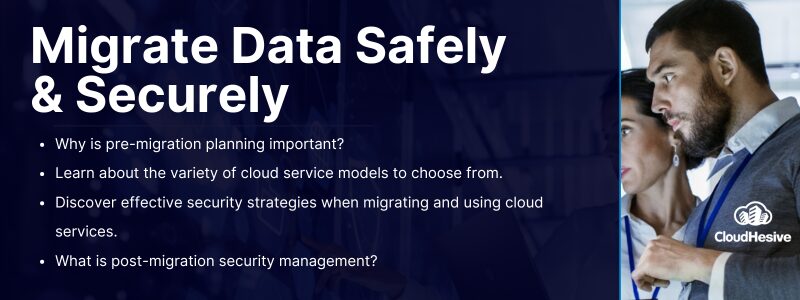Cloud migration security strategies
Data is a valuable business asset, making it a prime target for thieves and malicious cyber actors (MCAs). The attraction of MCAs to the cloud is simply the volume and variety of sensitive data stored in one place, with a variety of potential security loopholes to access it. When businesses migrate to the cloud for the benefits, it also comes with a need to strategize on how to apply advanced security measures to protect business data and assets during the migration and when stored in a cloud system.
In cloud environments, ensuring data security through identity and access management (IAM) and preventing social engineering for access credentials is key. Utilizing multifactor authentication (MFA) requires diligent security methods to prevent accounts from being exploited to grant access to unauthorized users, or MCAs.
This guide provides information on cloud migration security strategies to keep your business data secure by planning for pre-migration, migration, and post-migration stages.
Pre-migration planning
The cloud migration process starts with pre-migration planning. During pre-migration planning, the business, and the cloud service provider (CSP) come together and create a strategy for migration and security. A risk assessment is performed by the CSP to fully understand the existing IT infrastructure, data, and security procedures. During the risk assessment, the CSP identifies the location of sensitive data and identifies what regulatory compliance requirements exist.
Most CSPs will suggest a cloud service model that fits the business. The business and CSP decide on a cloud model and then together design a security strategy for the migration as well as post-migration. Any gaps or vulnerabilities in security are identified, and changes are implemented before the migration process begins. At CloudHesive, the pre-migration planning steps are:
1. Assess the cloud’s readiness.
2. Mobilize the migration by breaking the process into logical steps to ensure security and compliance.
3. Migrate and ensure all business assets and data are securely transferred.
As part of pre-migration planning, the business determines what cloud model suits its purpose.
Cloud model options include:
- IaaS (infrastructure as a service)
- SaaS (software as a service)
- PaaS (platform as a service)
PaaS is a viable option when your applications include multiple integration points. For example, PaaS is often used when development utilizes containers or deploys to a managed platform.
IaaS is a utility model used for data storage, firewall protection, and load balancing. When applications use backend-type processes, IaaS is a solid option.
SaaS is a popular option that provides user access to defined applications. For example, if users need to work in Microsoft Office 365, Slack, or other business applications. SaaS also provides automated IT management for deployments, security, and system maintenance.
As part of pre-migration planning, ensure the CSP understands how the business uses applications. For example, if you are using the Microsoft system, the plan needs to include setting Windows up to run on AWS (or other cloud systems). The more details in the pre-migration plan, the more accurate the migration.
Secure migration strategies
Effective cloud security starts with strategies for access control. Access control includes identity management, multifactor (MFA), and single-factor authentication. Single-factor authentication uses passwords and PINs but is susceptible to phishing. MFA significantly improves access security with codes sent to users or using a biometric like a fingerprint or facial recognition.
It is recommended that MFA methods be paired with phishing-resistant options like a public key (PKI) based identity for hardware-based online security. Other options include properly managing PKI certifications for authenticating users on the server side. Your CSP can direct you to the best option that pairs with the provided security options.
Data security practices in the cloud require the use of data encryption across the board. O for all sensitive data, at minimum. Plan on securing all interactions with cloud-stored data. Suggested encryption use includes the CNSA (Commercial National Security Algorithm) at minimum. Ensure sensitive data is never accessed through insecure channels. All web connections should be encrypted using TLS 1.2 or higher. Your CSP also provides options you can integrate into your system to effectively encrypt data both on the server and client sides.
Network security is another security strategy to plan and configure properly. Consider implementing Zero Trust (ZT) protocols to fully secure your network. ZT security principles include tying identity information to every network request, using end-to-end encryption, and micro-segmenting the network. Work with your CSP to design the network security they support by configuring network security properly. Enforce Zero Trust protocols and include firewalls and VPNs for access.
Post-migration security management
The post-migration phase security practices mean users can maximize the benefits of the cloud quickly.
Post-migration practices include:
- Monitoring the entire cloud environment for application performance and network traffic.
- Monitoring, logging, and auditing provide active tracking for network issues, security attempts, and compliance measures.
- Consider adding reporting to audit tracking for easier access to compliance measures.
- Create a security incident team that’s responsible for scanning logs for suspected security attempts as well as managing and responding to any incidents promptly.
- As part of your security response, create a full disaster recovery plan with the help of your CSP.
- Know what decisions need to be made promptly to limit damage and contain all security incidents immediately.
Post-migration is not only the end of the migration road but also the beginning of effectively managing and securing your cloud system.
Leveraging cloud provider security features
Most CSPs work on a shared security model. Major CSPs provide built-in security features. AWS, Azure, and Google Cloud all include a selection of tools for setting and managing cloud security. Now, it’s true that the CSP takes on some of the operational burden of security; however, the business must understand how to properly secure their assets.
When working with a CSP, be sure who’s responsible for what security is documented and defined. Ask for assistance if the setup is not clear, or you’re unsure whether an item needs to be secured. Don’t make the mistake of leaving a back door open for MCAs. Beware of leaving gaps or vulnerabilities.
Under a shared security model, a business is always responsible for securing everything under its direct control, including:
- Data and information.
- Application logic and code.
- Identity and access control.
- Platform and resource configuration settings.
- Secure all endpoints and dependencies that connect to the cloud, including on-premise servers, devices, networks, communication layers, and applications.
- Set up monitoring and auditing for all systems under your control.
Work with your CSP to understand how to use the provided security tools and settings. Most CSPs offer direct assistance, tutorials, or training programs.
Advanced security technologies and future trends
Security is constantly evolving due to the increasing number and complexity of threats. As security moves into the future, you’ll notice security becoming less reactive and more proactive, predictive, or offensive. The goal is to fully eliminate all threats before they do any damage or access any secured data.
Proactive security means businesses and CSPs fully protect each other’s assets. No more vulnerabilities to exploit and no gaps in effective security coverage. Investments are being made in creating tools and solutions that leverage AI and ML to provide predictive and proactive system security. AI and ML not only detect threats but shut them down immediately with detailed incident reporting.
Major CSPs, government entities, and businesses are actively working on using Quantum computing for proactive and preventive security. Quantum computers make systems more resistant to attack.
Full network encryption with Zero Trust security principles is another option already being put into use. Zero trust principles include tying identity information to network requests, implementing end-to-end encryption, and micro-segmenting networks for greater control and protection.
Cloud security and compliance will not get easier, but they are certainly becoming more proactive. CSPs and businesses need to work together to ensure full cloud security and ongoing compliance with a world of regulatory requirements around the use of data.
CloudHesive partners with your business with a dedicated and experienced cloud security and compliance team. Together, we’ll design a robust and compliant security strategy that keeps your business data secure before, during, and well after a cloud migration is complete. See what our customers say about working with CloudHesive. Contact us today!




